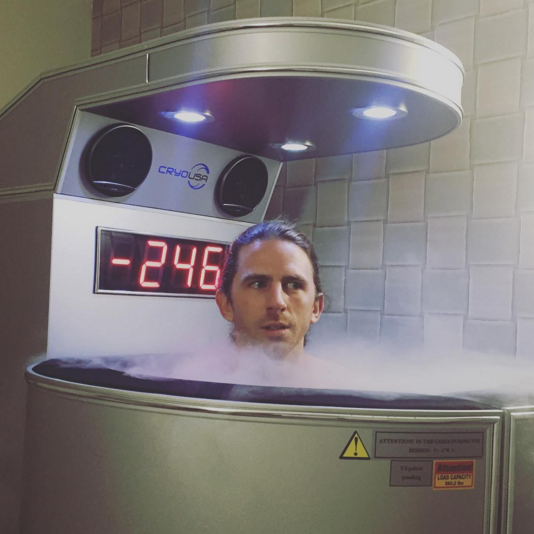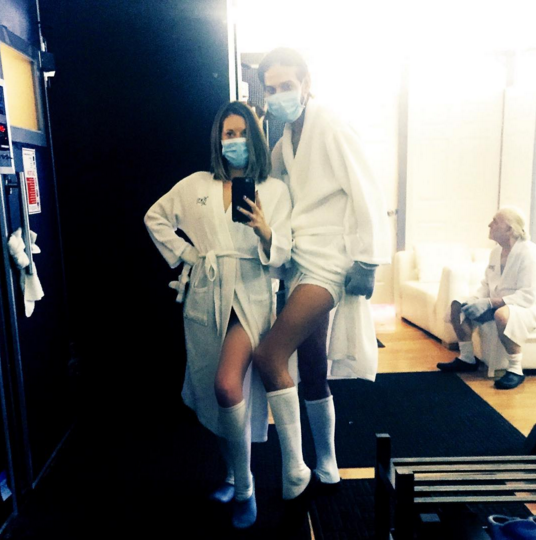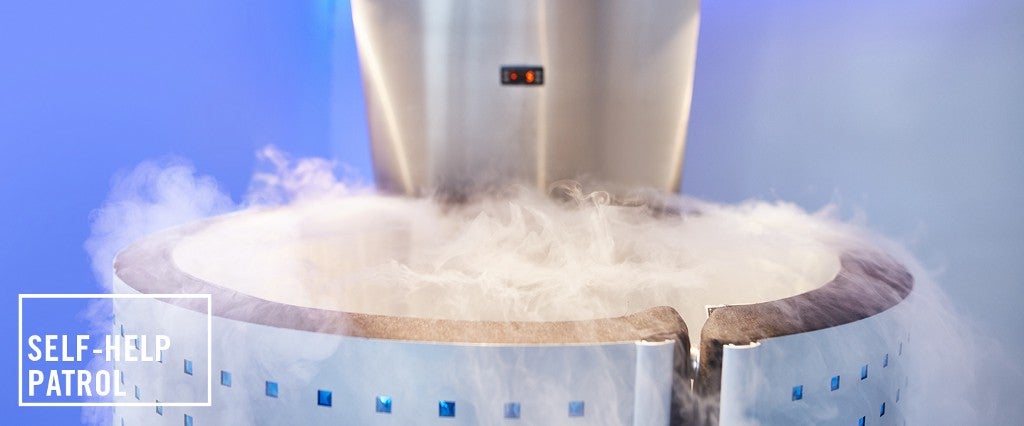Hypothermia officially sets in when our body temperature descends below 95 degrees Fahrenheit, causing the severely chilled individual to shiver, slur, stumble and, occasionally, to become so confused that they might even tear off their one remaining protection against the cold: their clothes.
For those who subject themselves to cryotherapy — the increasingly trendy treatment for muscle soreness that involves sitting in a –250 degree Fahrenheit “sauna” for up to three minutes — frantically disrobing isn’t an option (and neither is hypothermia, really, which would take a lot longer). This therapy is done in the nude, allowing for maximum skin exposure to the dry icy air. But a sense of confusion washes over you, nevertheless, somewhere around 90 seconds in — frantic and urgent, so disorienting that it borders on euphoria.
While trying cryotherapy at two different centers in Los Angeles last week, my only response was to try to keep moving. First, spinning round in circles in my first “cryosauna” (a full-body experience which left my head exposed). Second, dancing to the reggaeton that conveniently blasted inside the Whole Body Cryotherapy chamber (which looked more like a conventional walk-in sauna).
“It’s different, right?” the attendants in both locations asked me as I descended post-therapy, my body shaking under the provided thin white robes, white plumes of nitrogen gas vapor streaming out behind me.
Different, indeed. And for the most part, fun — particularly when done alongside a friend, ready to laugh with as you both change into the provided knee-high socks, slippers and gloves (to protect vulnerable digits from frostbite). Or to take photos of each other, either with one’s head peaking out of the cryosauna or when making your shivering exit from the cabin. Cryotherapy happens to be quite Instagram-friendly.
But did I feel differently after my treatment? I have my doubts that cryotherapy does anything (for most casual users) other than serve as novelty.
Goal
To feel “better”—that is, however you might be defining “better” on any given day. Invented in Japan in the 1970s, cryotherapy has been used since then to treat arthritis, and more recently to help with pain associated with fibromyalgia and extreme soreness.
Cryotherapy centers will often list any number of ailments that patients claim are helped by treatment — including insomnia, stress, mood disorders, skin conditions. According to practitioners, it has helped people lose weight, boost circulation and replenish organs and tissues with nutrients in the blood — in addition, claiming that these benefits will accumulate over time.

Method
After you’ve changed into the aforementioned cryotherapy outfit, an attendant will guide you into the chamber and proceed to make sure you don’t freeze to death. (The no. 1 rule of cryotherapy? Never cryo alone: an attendant in Las Vegas was found dead last year after a solo cryo session went awry.)
Once you’re inside, it’s next to impossible to see through the thick fog of white smoke. To keep you focused, a robotic voice reminds you how many bone-chilling seconds are left several times per minute. The music is loud. It feels like SoulCycle, but very, very cold.
If you’re allowed to keep your head free (in the cryosauna), it’s much less atmospheric. I was able to have a conversation with people outside of the capsule-like tank that came up to my neck. Thanks to that, the whole experience felt more medical than turnt — when in reality, it’s neither.
A single freezing will last two or three minutes, and the intensity of the freeze goes from not-so-bad, to intense, to actually-really-fucking-intense (for the last 30 seconds), and then you’re done. At the height of the cold—particularly in the whole body cabin—I did feel something sort of like a natural high of just intensified fuckedupness from the heightened stress of the moment. Was this my body starting to go into panic mode?
But before I could figure that out, it’s all over. Cryo is designed for people to get in and out quickly — to speed along its frequent users. Unlimited monthly memberships cost between $300 and $400. Otherwise it’s $65 a session (cheaper when bought in bulk).

Is there any science behind it?
Much is anecdotal. Patients with fibromyalgia who received 15 back-to-back sessions of cryotherapy reported “a more pronounced improvement of the quality of life” than the test group. So did some patients with “frozen shoulder” syndrome — a condition where patients feel stiffness and pain in their shoulder joints. Supposedly, cryotherapy is good for athletes to use when recovering from soreness, but a 2015 review of research on the matter concluded that currently available evidence was “insufficient” to recommend or debunk the treatment. Could athletes be just as healed with conventional ice water baths? Perhaps.
It sounds, mostly, like many different people have had their own personal success stories — it solved x, it fixed y — that may be hard to replicate. But that won’t stop anyone from trying whatever they can to achieve either pain management or general self improvement (all the way to the bank).
Who is this for?
The cryotherapy crowd is a mix: people old and/or rich, those concerned with anti-aging practices—along with the usual injured jocks and biohackers. As a spa treatment, the group bonding aspect is key: Near Hollywood on Sunday, the cryosauna was bustling with a crowd that seemed vaguely post-brunch. Two guys take pictures of their friend as he emerges from the cabin, screaming. A regular hands her puppy to the attendant to hold while she does 3 minutes in the chamber, soundtracked to her request: the new Kelly Clarkson.
Did it work?
While the pain in my sciatic nerve was not switched off, I went twice back-to-back to see if a second time would feel any differently.
Beyond the immediate thrill, I didn’t notice any change to the way my body felt. Perhaps if I told that to a cryo-professional, he would tell me to go a few more times to see a change. I already feel as though the deep freeze will not be the key to my pain issues, but it’s hard to argue with other peoples’ success stories. Bottom line: science doesn’t really think so.
If you’re still interested in trying, look for a spa that offers a discounted rate for intro sessions — and bring your friends.
Zak Stone edits Self-Help Patrol. He last reviewed the Kondo method.
More Self-Help Patrol:
- Self-Help Patrol: The Road to Ultimate Happiness Is Paved in Garbage
- Self-Help Patrol: Finding My Muse
- Self-Help Patrol: The Sound of Solace

